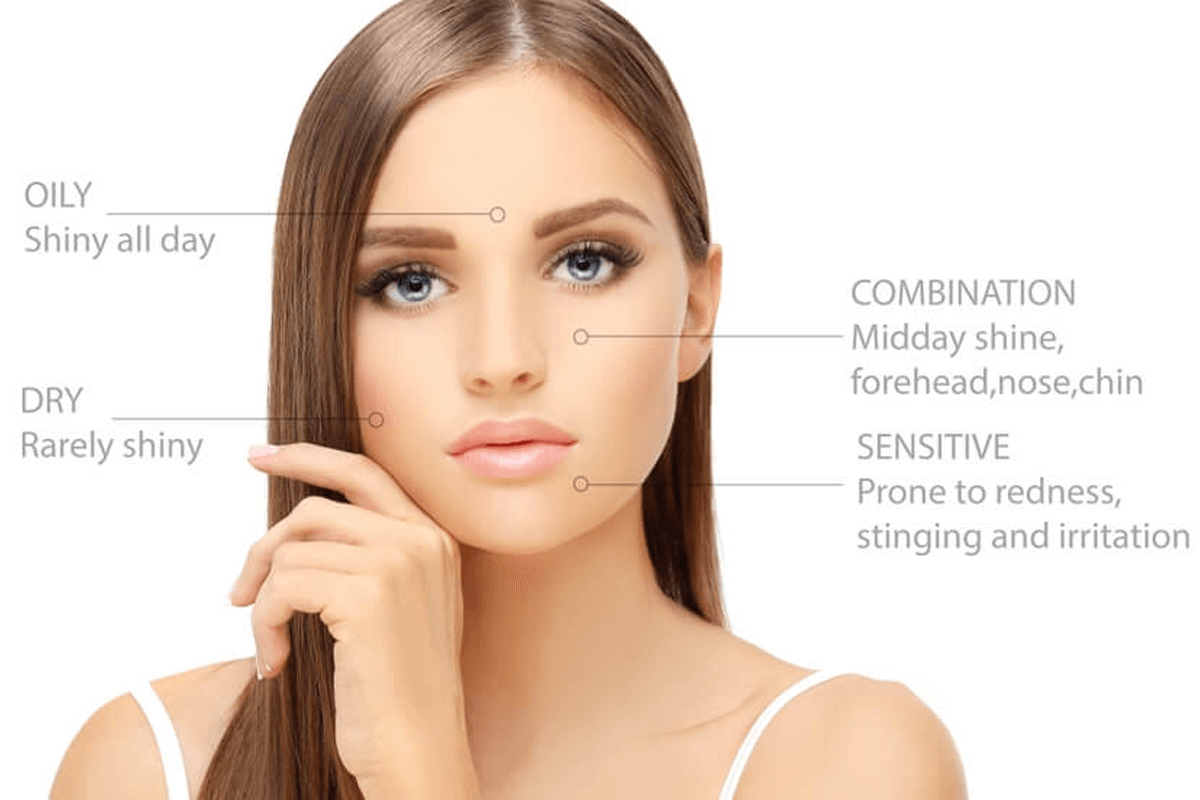Do you want to know how to determine skin type and why it’s important? The most crucial step in skin care is understanding your skin type and how it adapts to different situations or seasons. Your skin is the largest organ in your body and is as complex as your heart, lungs, liver, and other vital organs.

Every person’s skin is different, but a few common skin types can help you in telling how to identify your skin type. These three skin types are the most prevalent: oily, combination, and dry. But before we get into each type and how to care for it, here’s how to figure out your skin type. There are two simple methods for determining your skin type at home.
Why Do You Need To Know What Is Your Skin Type?
Knowing your skin type is essential to ensure that any skin care products you choose are appropriate for your skin type. If the product isn’t suitable for your skin type, it won’t be as effective and may aggravate or cause new problems. That is why here is how to find out your skin type.
What Are The Different Types Of Skin?
There are five skin types, but many people have skin types slightly above or below the standard types. Learn more about the different types of skin in this section and learn how to determine skin type.
1. Oily Skin
A surplus of sebum produced by oily skin makes the skin appear glossy and greasy, especially in the T-zone means the forehead, nose, and chin. Still, they may also be more prone to enlarged pores, acne blemishes, clogged pores, and blackheads. Remember, simply because oily skin produces more natural oils doesn’t mean it needs less moisture than other skin types.

Using products that moisturize and feed your skin without blocking pores or creating breakouts can assist oily skin. A gentle, foaming cleanser that completely nullifies dirt, excess oil, and other contaminants is essential for oily skin. It should also include a lightweight, oil-free, non-comedogenic moisturizer to give your oily skin the hydration it requires.
2. Dry Skin
Dry skin produces fewer natural oils than other skin types. This can make it appear dull, rough, flaky, or even scaly. If your skin feels tight or less elastic and may have more obvious fine wrinkles. Moreover, it could itch or bother you means your skin is dehydrated.

For example, ceramides should be used in a dry skin skincare regimen since they support the preservation of the skin’s barrier of protective moisture. It recommends avoiding excessively long, hot showers, moisturizing multiple times daily, and using fragrance-free, non-comedogenic, and alcohol-free skincare products for dry skin types.
3. Normal Skin
Normal skin is balanced, not too dry or too oily. It doesn’t produce pimples, flakiness, a greasy or tight sensation, or outbreaks. People with normal skin typically have tiny pores and smooth skin and are less prone to sensitivity or blemishes.

On the other hand, normal skin requires proper skincare even if it has no specific issues or concerns. The ideal regular skincare routine keeps your skin hydrated by locking in moisture and supporting your skin’s protective barrier.
4. Combination Skin
Combination skin has dry and oily areas, with the T-zone typically being oily and the cheeks being either dry or normal.

This skin type can change with the seasons due to various factors, such as stress or hormone fluctuations. Cleansing and hydration are essential for caring for oily or normal skin in some areas but dry in others.
5. Sensitive Skin
Sensitive skin is frequently referred to as a skin type, but you can have oily, sensitive, dry, sensitive, or normal sensitive skin. Your sensitive skin may appear red and feel burning, itching, or dry, regardless of your skin type. These symptoms may be brought on by specific chemicals, such as colors or scents, as well as environmental variables, and they may be connected to skin that is more sensitive to external irritants.

If you have sensitive skin, you can identify what causes your sensitivity and avoid using cleansers, moisturizers, or other products that contain those ingredients. To reduce your exposure to triggers, you can also alter your environment.
How To Check Your Skin Type?
There is a foolproof step-by-step guide to determining your skin type; follow the instructions below and learn how to determine skin type.

1. Examining Your Skin
Apply a tissue to your face. After washing your face, wait an hour before patting your T-zone with a tissue. Examine the tissue to see if the oil has rubbed off on it. If so, you have either oily or combination skin.
Your T-Zone is comprised of your brow and nose. The T-zone is so named because the bridge of your nose forms the base of the “T.” The area of your forehead above your brows includes the top of the “T.”
2. Feel Your Skin
Dry skin will feel tight after cleansing, whereas oily skin will feel cleaner immediately after washing. If you have combination skin, your T-zone will feel clean, but your cheeks will feel tight. Specific cleansers may cause itchy skin or a rash in people with sensitive skin.
- If you have sensitive skin, certain facial products may cause your face to become red and itchy or a rash to form.
- As the day progresses, oily skin will begin to feel greasy again.
- If you notice that your skin does not fit into any of these categories and that you are free of problem areas, you have normal skin that requires little maintenance!
- Pimples or acne can appear at any age, especially if you have oily skin.
3. Check How You Are Looking.
You most likely have dry and sensitive skin if you have red, flaky patches all over your face. You have oily skin if your look is shiny all over. You have combination skin if you have a combination of both.
4. Look For Open Pores
Your pores will be visible but not prominent if you have normal skin. Remove your gaze from the mirror. You have oily skin if you can still see your pores. The absence of visible pores defines dry skin.
When you have more than one pore size on your face, you have combination skin, a mix of dry, oily, and normal skin.
5. Pinch Your Skin.
You have dry or combination skin if your skin wrinkles easily when pressure is applied. Smoothness will be felt by oily skin.
6. Ask Your Dermatologist.
Consult a dermatologist if you still need to decide on your skin type. If all else fails, they can prescribe over-the-counter medications and perform procedures to treat your dry, oily, sensitive, combination, or acne-prone skin.
How To Treat Your Skin?
So you’ve learned how to determine skin type, but what now? Learn how to treat your skin to achieve healthy, glowing skin properly.

1. Moisturize Your Dry Skin
Apply a fragrance-free cream to your skin’s dry areas. Use only a little soap when showering; use warm, not hot, water.
Soap should only be used on dirty parts of your body, such as your armpits, groin, under your breasts, and between your toes. Using soap all over your body can dry and irritate your skin.
Dermatitis can also be caused by dry skin. In this case, apply hydrocortisone ointment to the affected areas.
2. Clean Your Face Twice A Day
Wash your face for 30 seconds to a minute with a gentle facial cleanser and warm water. Face products containing benzoyl peroxide, alpha hydroxy acid, and retinoids can be used to treat problem areas. You can also use glycolic acid or salicylic acid products. Purchase a small sample before attempting these spot treatments or medicated pads to determine which works best for your face.
- Blotting paper can also be used to remove excess oil from your face. For about 15 seconds, press it against the oily area. This will absorb the oil and reduce the shine on your face.
- Make sure to complete the moisturizer. Even oily skin requires moisture; use an oil-free moisturizer.
- To combat oily skin, avoid using too many products at once. Excessive skin drying can cause your skin to produce more oil to compensate.
3. Find The Best Treatment For Combination Skin
To wash your face, use a fragrance-free gentle cleanser and avoid soaps with harsh chemicals. Consume essential fatty acid-rich foods such as salmon, flaxseed, and walnuts, or take a fish oil supplement. This will moisturize your skin without adding oil.
4. Use A Facial Cleanser On Sensitive Skin.
Use a gentle facial cleanser with no added fragrance or chemicals to avoid skin irritation. Moisturize your skin to prevent dry spots from breaking. Before using skin products, apply a small amount behind your ear to the side of your eye, and observe how it reacts overnight.
5. Stay Hydrated All Day Long.
If you want a healthy complexion, drink plenty of water. When your skin is dehydrated, it produces more sebum (oil) to keep itself lubricated. Your skin will thank you if you stay hydrated.
Conclusion
To summarize, this article explains how to determine skin type with a simple process. Follow the steps to learn about your skin types and how to treat them. Visit fitternify.com for more articles on fitness, health, and beauty.


